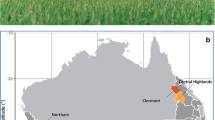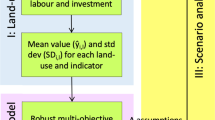Abstract
The ability to use a knowledge of past market price fluctuations to reduce the risk of future financial returns is explored in the context of planning an agroforestry system with a cash crop component. It is demonstrated that if past crop price behavior is indicative of future price behavior, planting crops with stable and/or negatively correlated net revenues can reduce the variance of future net revenues and hence decrease the financial risks of agroforestry systems.
Similar content being viewed by others
References
Altieri, MW (1987) Agroecology: the scientific basis of alternative agriculture. Westview Press, Boulder, CO. 227 p
Antle, JM (1989) Nonstructural risk attitude estimation. Amer J Agr Econ 71: 774–784
Betters, DR (1988) Planning optimal economic strategies for agroforestry systems. Agroforestry Systems 7: 17–31
Binswanger, HP (1980) Attitudes toward risks: experimental measurement in rural India. Amer J Agr Econ 62: 395–407
Blandon, P (1985) Agroforestry and portfolio theory. Agroforestry Systems 3: 239–249
Burgess, J (1981) The intercropping of smallholder coconuts in Western Samoa: An analysis using multi-period linear programming. MADE Research Series No. 4, The Australian National University, Canberra. 270 p
Cannell MGR (1983) Plant management in agroforestry: manipulation of trees, population densities and mixtures of trees and herbaceous crops. Pages 455–487 in PA Huxley, ed, Plant Research and Agroforestry. ICRAF. 617 p
Dillon, JL and Scandizzo, PL (1978) Risk attitudes of subsistence farmers in northeast Brazil: a sampling approach. Amer J Agr Econ 60: 425–435
Dykstra, DP (1984) Mathematical programming for natural resource management. McGraw-Hill Book Co, New York, NY. 318 p
Hazell, PBR and Norton, RD (1986) Mathematical programming for economic analysis in agriculture. Macmillan Publ Co, New York, NY. 400 p
Hoekstra, DA (1985) Choosing the discount rate for analysing agroforestry systems/technologies from a private economic viewpoint. Forest Ecology and Management 10: 177–183
Liebman, J, Lasdon, L, Schrage, L and Waren, A (1986) Modeling and optimization with GINO. The Scientific Press, San Francisco, CA 193 p
Low, ARC (1974) Decision taking under uncertainty: a linear programming model of peasant farmer behavior. J Agr Econ 25: 311–320
Markowitz, HM (1987) Mean-variance analysis in portfolio choice and capital markets. Blackwell Inc, New York, NY. 387 p
Mead, R and Willey, RW (1980) The concept of a ‘Land Equivalent Ratio’ and advantages in yields from intercropping. Exper Agr 16: 217–228
Raintree, JB (1983) Bioeconomic considerations in the design of agroforestry cropping systems. Pages 271–289 in PA Huxley, ed., Plant Research in Agroforestry. Int'l Council for Research in Agroforestry, PO Box 30677, Nairobi, Kenya
Verinumbe, I, Knipscheer, HC and Enabor, GE (1984) The economic potential of leguminous tree crops in zero-tillage cropping in Nigeria: a linear programming model. Agroforestry Systems 2: 129–138
Author information
Authors and Affiliations
Additional information
This research was supported by the Utah Agricultural Experiment Station, Utah State University, Logan, Utah 84322-4845. Approved as journal paper no 3903.
Rights and permissions
About this article
Cite this article
Lilieholm, R.J., Reeves, L.H. Incorporating economic risk aversion in agroforestry planning. Agroforest Syst 13, 63–71 (1991). https://doi.org/10.1007/BF00129619
Issue Date:
DOI: https://doi.org/10.1007/BF00129619




